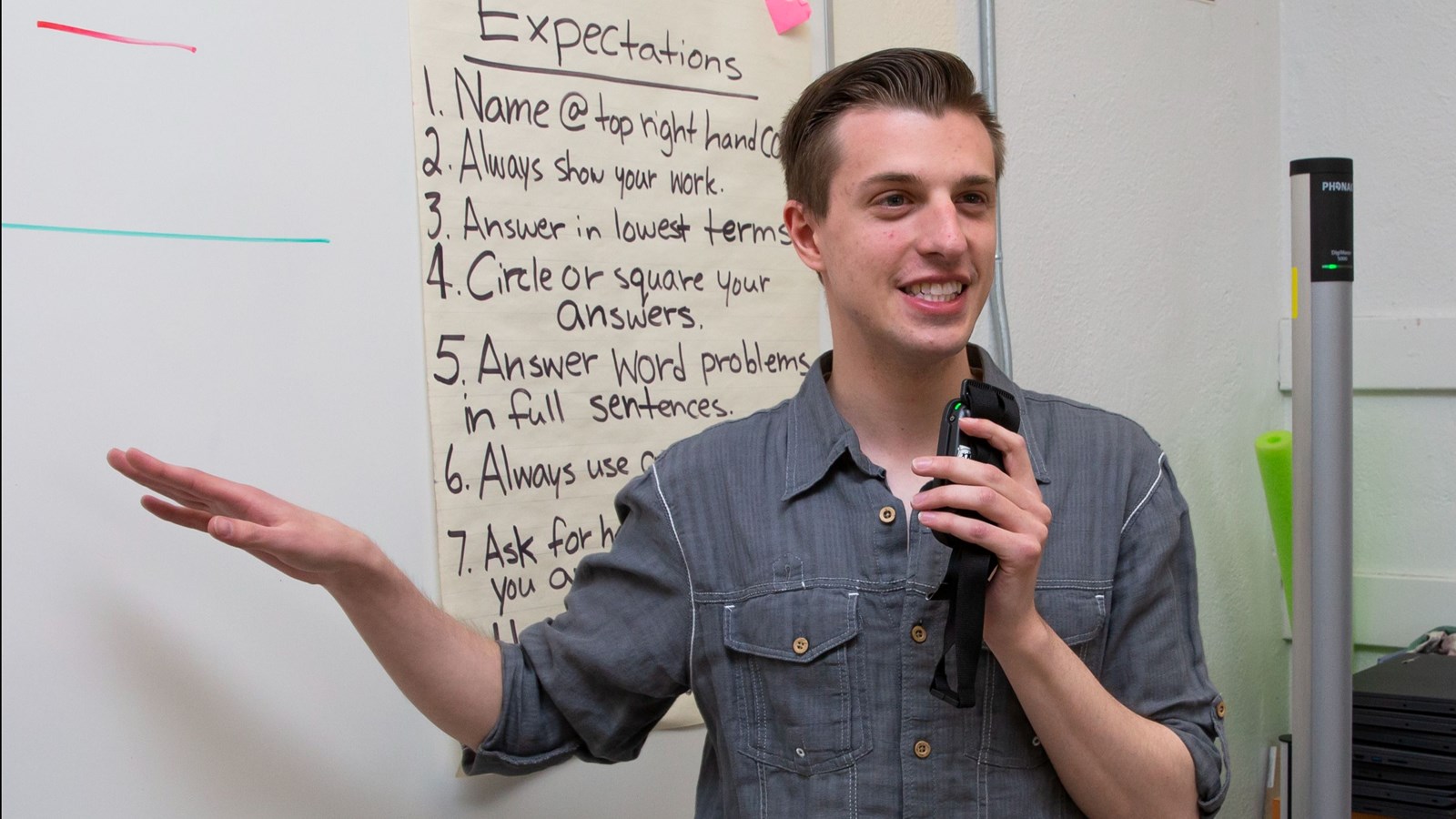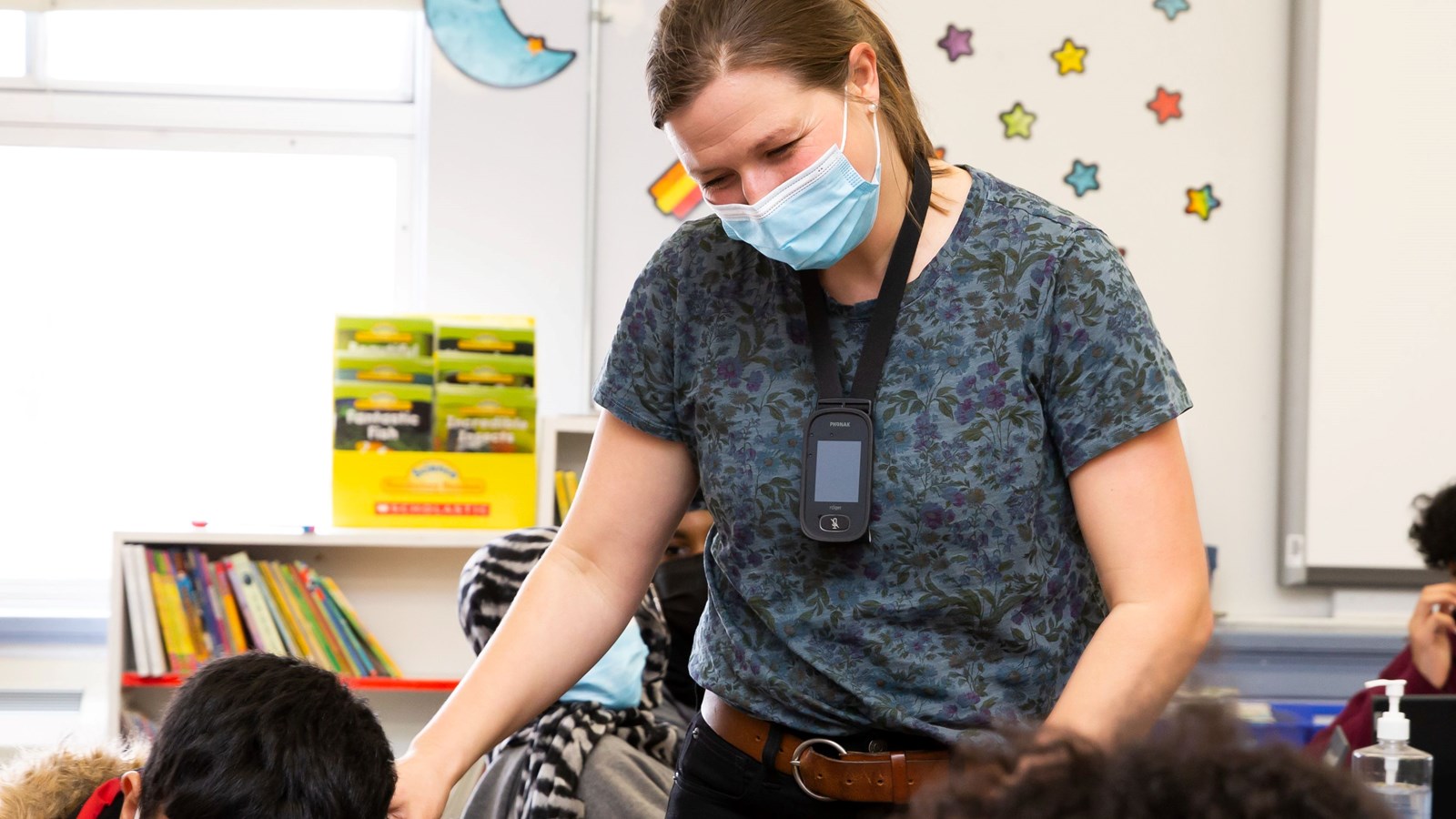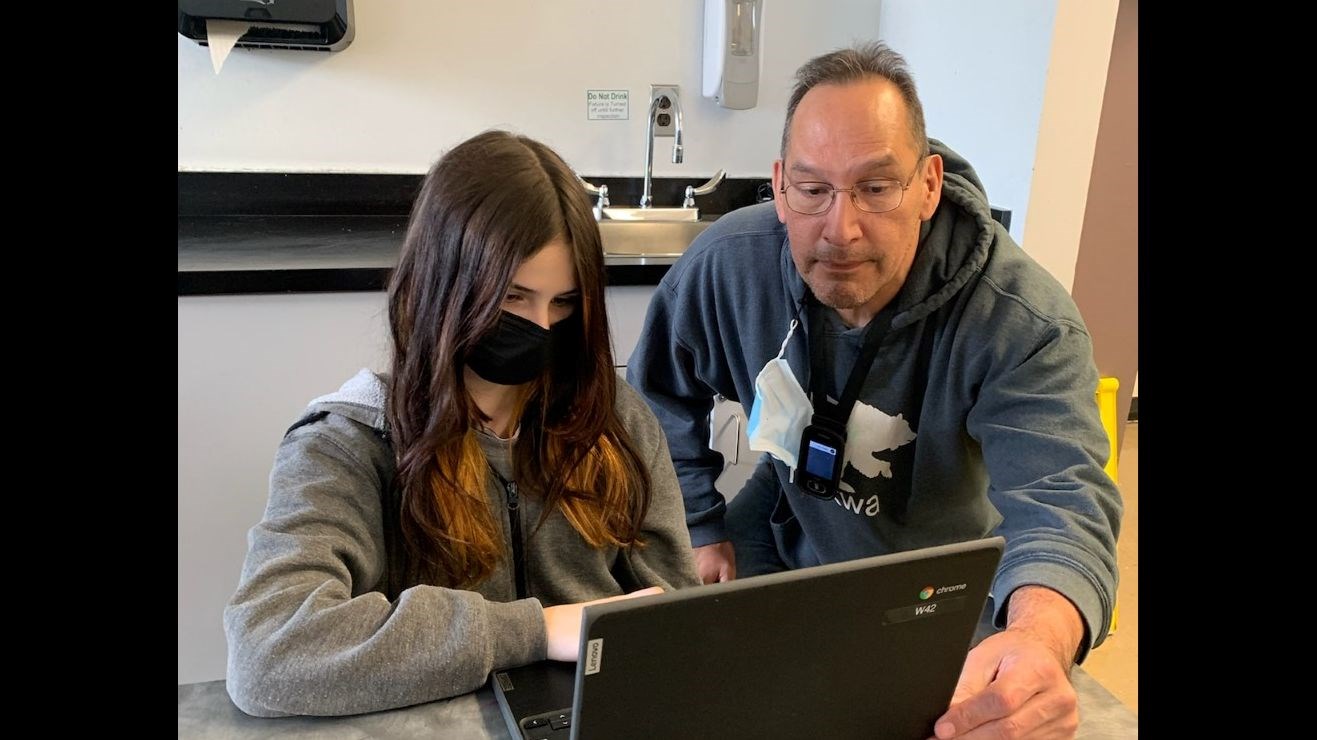Sound science – Classroom sound systems enhance learning for all
May 27, 2022 News Story
A WSD junior high school is seeing benefits across the student population after miking up teachers in every classroom.
Hugh John Macdonald School invested in sound field FM systems in all of its classrooms this school year.
Sound field FM systems amplify a teacher’s voice to provide improved audibility for all students in the classroom. The devices consist of a wireless microphone and speakers, and can connect via Bluetooth to students’ hearing aids.
The move has paid off not only for students who are hard-of-hearing, but for students and teachers throughout the school.
“It is a really simple piece of technology and very inexpensive, but has a huge impact because it does benefit everybody in the classroom,” said Maxine Flaman, an Audiologist with the WSD Clinical Support Services’ Audiology Department. “Study after study has shown that the benefits of using these systems in the classroom are not just acoustic, but we get better classroom behaviours, we get happier classrooms. The teacher isn’t raising their voice to be heard.”
Hugh John Macdonald Principal Matthew Adkins was motivated to investigate sound field FM systems after attending a Celebrating Inclusion Conference at École Stanley Knowles School a few years ago; one of the presenters happened to be Ms. Flaman, who discussed the systems and their impacts on student learning.
“When you look at the modalities of teaching, we have the visual side of things, but a lot of teaching is auditory,” Mr. Adkins said. “The sound field system levels the playing field for the kids no matter where they are sitting in the classroom.”
After focusing on the visual realm of learning over the past several years—such as installing LCD projection systems in every classroom and class sets of chromebooks—the school decided to apply the same whole school approach to auditory learning.
Mr. Adkins consulted with the leadership group at Hugh John Macdonald, who in turn consulted with teachers school wide; Ms. Flaman also visited the school to do a follow up presentation for teachers.
“We came to a decision as a staff that this was something we would invest our time and money in…and so far, it has turned out really well,” Mr. Adkins said.
Signal-to-noise
Classrooms are typically busy places, and both teachers and their student listeners are working against several variables when it comes to acoustics: the distance from the student and teacher, reverb/echo in a room and background noise such as fans, shuffling papers, pen-clicking, and talking during group work.
Ms. Flaman noted that sound field FM systems improved a teacher’s signal-to-noise ratio in the classroom.
“The use of a sound field FM system compensates for all of those variables,” Ms. Flaman said.
“Think of those kids who have borderline hearing sensitivity, or have concerns or difficulties with attention…if we can ensure they are hearing the teacher’s voice, then we are benefitting them as well.”
The culture of sound
Another aspect that was of particular interest to Hugh John Macdonald staff was how a raised voice could be interpreted differently by students if they have experienced trauma. Sound field FM systems address the issue by removing the necessity for teachers to project or raise their voice to teach.
“Ms. Flaman pointed out that with some of the students in our population, a raised voice can be associated with past trauma. If a teacher is raising their voice because they are trying to project above background noise, without intending it that can come across as yelling or that they are angry. Students who have experienced trauma can go into fight or flight mode, or enter a state where they are reflecting on that trauma. And that can impact their learning,” Mr. Adkins said.
For students who are learning English, the improved sound can also have a positive impact on learning.
“Our language centres for our newcomer students in our school are both equipped with sound field systems. When students are acquiring a new language, hearing the enunciation is really key. The students get a better experience,” Mr. Adkins said.
Hard-of-hearing students
The Audiology Department always recommends sound field FM systems for children who are hearing impaired. The department has an inventory of systems that are assigned to these students.
Through Bluetooth technology, the teacher’s voice can be amplified directly into the student’s hearing aids. The devices can also broadcast sound from movies and other audio-visual presentations directly to these students.
Hugh John Macdonald teacher Heather Schellenberg said she has found the systems useful when working with students in her English-as-an-additional language classes; it has also improved classroom interaction for students who use hearing devices.
“It seriously changes the student’s involvement and engagement in class completely,” she said. “I think it also helps with behaviour management and the teacher’s energy levels, because you don’t have to raise your voice. It helps you to stay calm and steady throughout the day.”
Positive feedback
English teacher Warren du Plooy, who has been teaching at Hugh John Macdonald for 12 years, said it only took a short time for both him and his students to get used to the classroom sound system.
“I think within a day, kids were used to it,” he said. “And I loved it right from the start. If I’m reading a novel to the students, I can read a full 15-20 minutes, and read it like a book is supposed to be read and not shout my way through it so the kids at the back can hear.”
First-year teacher Luca Burroughs, who teaches Grade 7-9 Mathematics at the school, said the devices have been helpful, particularly when it comes to avoiding vocal strain—a common ailment amongst teachers, who rely on their voices so much every day.
“It’s very helpful. I noticed even in my first few months here before we got them, my voice was strained all the time from trying to project,” Mr. Burroughs said. “Now I find I can talk at a normal level and it’s loud enough for the students to hear me. I’ve also noticed that I don’t have to repeat myself as many times. Everyone hears me all at the same time.”
Claire Rodger, who also teaches Grade 7-9 Mathematics, said the sound field systems have been a powerful tool that allows her to reflect on her day-to-day classroom practises.
“I’ve noticed that I articulate and enunciate my words a lot more clearly, and it allows me to really hear what I am saying. My voice is reaching all the corners of the room, so the students are getting all the little nuances,” she said. “I think it’s allowed me to create a more positive environment, because I’m so much more aware and monitoring not just what I say, but how I say it. So it has been a really positive tool for me to use.”
Teachers have noticed that student behaviours have improved and they are more on task in class.
“I’m noticing a huge turnaround just in terms of behaviour for students and also just how I’m reacting as well,” Ms. Rodger said.
Taking the initiative
Several years ago, the Audiology Department conducted a pilot sound field project, where systems were put in all Grade 1 classrooms in the Inner City. After the seeing positive outcomes through that project, the department explored the possibility of having a system in every elementary classroom.
While they were unable to proceed due to budgeting limitations, they have been encouraged to see schools allocating budget towards sound field FM systems.
A second WSD school, John M. King, has also committed to a similar schoolwide initiative.
“We’re really thrilled when we see schools take the initiative, as we know their budget dollars are really limited. And so for them to commit to a very fundamental basic in the classroom is really exciting to see,” Ms. Flaman said.
Systems are generally available at a cost of $1,000 per unit from the manufacturers after an education discount. Recognizing that initial budgetary consideration, the units have an average lifespan of 10 years, or a classroom cost of $100 per year. In a class of 20 students, that would equal approximately $5 per student per year, plus some maintenance costs.
“I can’t think of anything else that would cost $5 per year that would have such an impact,” Ms. Flaman said. “These systems benefit every single student and teacher in the classroom.


